Питер Уоттс - Vampire Domestication - Taming Yesterday’s Nightmares for a Better Tomorrow
Здесь есть возможность читать онлайн «Питер Уоттс - Vampire Domestication - Taming Yesterday’s Nightmares for a Better Tomorrow» весь текст электронной книги совершенно бесплатно (целиком полную версию без сокращений). В некоторых случаях можно слушать аудио, скачать через торрент в формате fb2 и присутствует краткое содержание. Год выпуска: 2005, Жанр: Фантастика и фэнтези, на английском языке. Описание произведения, (предисловие) а так же отзывы посетителей доступны на портале библиотеки ЛибКат.
- Название:Vampire Domestication: Taming Yesterday’s Nightmares for a Better Tomorrow
- Автор:
- Жанр:
- Год:2005
- ISBN:нет данных
- Рейтинг книги:4 / 5. Голосов: 1
-
Избранное:Добавить в избранное
- Отзывы:
-
Ваша оценка:
- 80
- 1
- 2
- 3
- 4
- 5
Vampire Domestication: Taming Yesterday’s Nightmares for a Better Tomorrow: краткое содержание, описание и аннотация
Предлагаем к чтению аннотацию, описание, краткое содержание или предисловие (зависит от того, что написал сам автор книги «Vampire Domestication: Taming Yesterday’s Nightmares for a Better Tomorrow»). Если вы не нашли необходимую информацию о книге — напишите в комментариях, мы постараемся отыскать её.
Conference on Induced Humanoid Subspecies
Peter Watts, Ph.D.
FizerPharm
Evoconsumables
Vampire Domestication: Taming Yesterday’s Nightmares for a Better Tomorrow — читать онлайн бесплатно полную книгу (весь текст) целиком
Ниже представлен текст книги, разбитый по страницам. Система сохранения места последней прочитанной страницы, позволяет с удобством читать онлайн бесплатно книгу «Vampire Domestication: Taming Yesterday’s Nightmares for a Better Tomorrow», без необходимости каждый раз заново искать на чём Вы остановились. Поставьте закладку, и сможете в любой момент перейти на страницу, на которой закончили чтение.
Интервал:
Закладка:
Photosensitivity. None of our subjects developed xenoderma pigmentosum (a rare photosensitive skin condition which some have linked to vampirism in the past). Vampires do have very sensitive night vision, however, and their pupils don’t react as quickly to ours to changes in light intensity; they can be easilly snowblinded, as you would be if someone shone a light in your face while you were wearing night-vision goggles. It wouldn’t cause them to burst into flame when struck by the sun’s rays, but it might explain a general aversion to bright light. A crowd of peasants with torches might present a real problem to these creatures.
None of our subjects developed any kind of aversion to garlic, or to any of the Amaryllidaceaen species. It’s possible that vampires themselves spread this rumour, to engender a false sense of security among their prey; why bother building crucifixes if you think some garden weed is going to protect you? It’s also possible that the whole story is pure fiction.
A lot of other myths—that vampires can fly, or shapeshift, or that they don’t reflect in mirrors—are likely to be mostly fiction as well. They do reflect in mirrors: that was one of the first things we tested. But it’s worth remembering that these creatures are both faster and more intelligent than we are, and their superlative pattern-matching skills would give them a real advantage in "blending in" via crypsis; it’s quite likely that one might seem to disappear simply by fading into shadow, or adopting a posture that broke up its outline against the background. Combine such a vanishing act with, say, the flushing of some startled animal caught in its path, and a primitive human might think that some kind of shape-shift had occurred.
Reproduction: as the classic mythology would have it, vampires reproduce by turning their victims into other vampires. Revisionists and horror writers have played around with the idea of vampirism as a kind of viral infection, an STD transmitted from saliva to blood. Biologically, of course, there are some problems with this idea: if you create another vampire every time you feed, it won’t be long before all your prey have been turned into vampires, all of which will get very hungry very fast. However, the idea isn’t as absurd as it may seem on the surface. Lateral gene transmission is not unheard of in nature; certain microbes are known to act as carriers for the DNA of other species, transmitting them from one host to another; and in any event, it appears that predator and prey share many of the same genes anyway; perhaps the only thing that needs to be transmitted is some kind of catalyst to activate them. More conventionally, vampires and humans never achieved complete reproductive isolation in any event; there’s no reason why interbreeding couldn’t produce vampire offspring, especially if the critical vampire genes were heterozygously dominant. This is one of the strongest arguments of the syndrome-not-subspecies contingent, who argue that if it walks like a duck, quacks like a duck, and has sex with ducks, it must be a duck even if it looks like a turkey vulture.
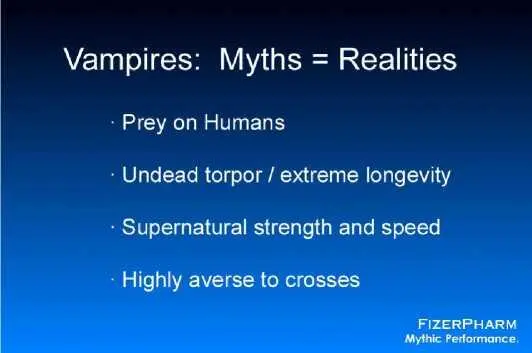
And let’s not forget those aspects of vampire lore that are, without question, biologically true: their predatory habits, their speed and strength, their undeath and long lives. And, of course, the crucifix glitch, which spelled the end of the vampire lineage— although they obviously persisted long enough to embed themselves in our cultural mythology, the book is pretty much closed on the biological organism [1] In fact, their extinction may have released the so-called Toba Bottleneck : most of the human race died off about 73,000 years ago, and numbers remained very low until about ten thousand years ago, during which time we began an unprecedented expansion that continues to this day. This bottleneck has traditionally been blamed on a massive volcanic explosion in Sumatra, and a consequent volcanic winter; but the timing is interesting, to say the least.
.
Or is it?
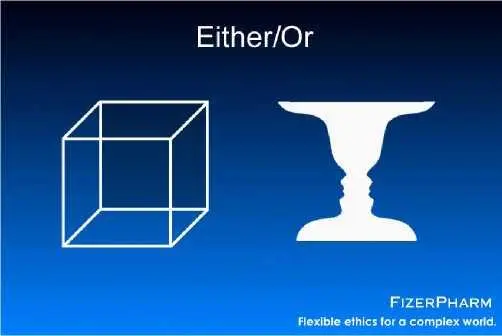
You’ll recognise these figures; a Necker Cube and a Rubin’s Vase, popular examples of the so called ambiguous illusion. Sometimes you see two faces, sometimes a vase. Sometimes the the shaded panel seems to be behind, sometimes up front; your perspective flips back and forth, you can see it one way, then another.
Vampires can see it both ways at once. They don’t have to flip back and forth: they can do something that’s neurologically impossible for us, they can hold simultaneous multiple worldviews. This allows them to instantly grasp things that to us seem plagued by contradictions, to see things we have to work out step-by-step. Take quantum physics. We humans have to be dragged kicking and screaming below the Planck length, we need complex math and numbers to force the truth onto us, and even then the truth makes no sense: Nothing is real until someone observes it? Effect before cause? A cat in a box, simultaneously dead and alive in some discorporeal state? The math forces us to accept the conclusion, but it violates everything we know about reality. But vampires understand quantum physics, right down in the gut. It makes sense to them.
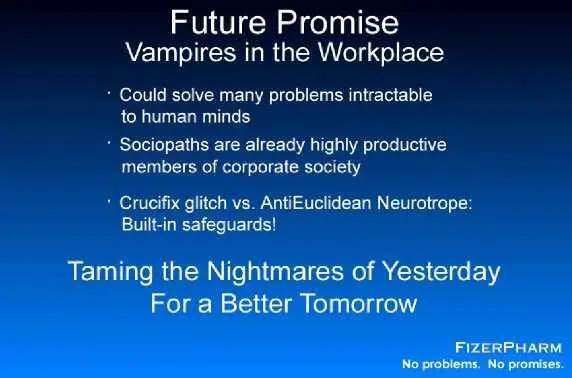
Think of the ways we could benefit from a creature. How many problems— political, environmental, technological, even philosophical— intractable to the human mind, might prove trivially simple to such a creature? Not even computers offer such problem-solving potential—because no matter how many computers you network together, no matter how many quantum or classical elements you plug in, you’re still dealing with a machine that was ultimately designed by humans and which therefore reflect the limitations and constraints of a human mindset. In contrast, we would not be designing vampires at all—evolution has done that for us. We would merely be resurrecting them.
Some might question whether vampires could ever fit in to modern society. But remember that modern sociopaths are, in effect, fragments of vampirekind, manifesting in a human body. And sociopaths are among the most successful players in business, industry, and medicine; ruthless pragmatism, lack of conscience, and freedom from fuzzy touchy-feely emotions like empathy are prerequisites of success in today’s corporate environment. In fact, corporations themselves, as legal entities, meet all the diagnostic criteria for clinical sociopathy under the DSM-IV. We know vampires could prosper in such an environment because, in a very real way, they already do.
The other question that arises is, even if they could solve all our problems, why would they? These are, after all, creatures that evolved to eat us, not give us a hand with our homework — and the usual alarmists from Greenpeace or the Sierra Club have already begun spreading doomsday scenarios in which we resurrect the vampires back only to have them wipe us out. And I’m the first to admit that you certainly wouldn’t want to bring these creatures back without some kind of safeguards in place.
But even here, the vampires prove to be our biggest ally—because vampires come with their own safeguards built right in! The crucifix glitch did them in once already, and it would kill them off even faster nowadays, in our right-angle-filled urban environments. In fact, the only way we were able to keep them from going into convulsions at the drop of a hat—and I’m revealling a bit of a trade secret here, but we’ve already patented the molecule—was by keeping them on a strict regimen of what we call antiEuclidean Neurotropes. We have developed a drug that suppresses the seizures resulting from the crucifix glitch, a drug which allows vampires to function normally in metropolitan settings; and without this drug they will die. We have them on a very short and unbreakable leash, and they are more than intelligent enough to realise that serving our interests in in their best interest.
Читать дальшеИнтервал:
Закладка:
Похожие книги на «Vampire Domestication: Taming Yesterday’s Nightmares for a Better Tomorrow»
Представляем Вашему вниманию похожие книги на «Vampire Domestication: Taming Yesterday’s Nightmares for a Better Tomorrow» списком для выбора. Мы отобрали схожую по названию и смыслу литературу в надежде предоставить читателям больше вариантов отыскать новые, интересные, ещё непрочитанные произведения.
Обсуждение, отзывы о книге «Vampire Domestication: Taming Yesterday’s Nightmares for a Better Tomorrow» и просто собственные мнения читателей. Оставьте ваши комментарии, напишите, что Вы думаете о произведении, его смысле или главных героях. Укажите что конкретно понравилось, а что нет, и почему Вы так считаете.
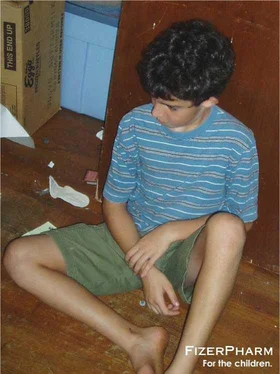


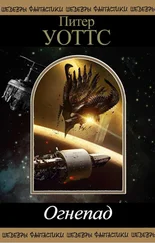
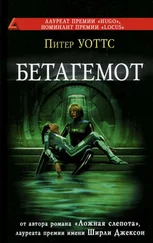






![Питер Уоттс - Водоворот. Запальник. Малак [litres]](/books/420290/piter-uotts-vodovorot-zapalnik-malak-litres-thumb.webp)